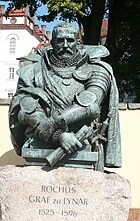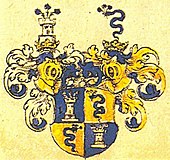Lynar
Lynar (or Linar ) is the name of a noble Prussian family that originated in today's Italy. A branch of the family later settled in Lübbenau in the Spreewald .
history
The old northern Italian family takes its name from the immediate county and the permanent castle Linari (in the upper Lamone valley near Marradi , on the immediate northern edge of Tuscany , on the border with Emilia-Romagna , near Faenza ), which the Florentines built in 1360 grind. Migliore Conte di Linari, son of Count Guido von Mutiliana, was the first to use this name in 1347.
According to research by Prince Ernst von Lynar, the family is said to have descended from the Count of Mutiliana from a Thuringian noble named Wido, who is said to have married an unequal daughter of Otto the Illustrious of Saxony in 933 . After his castle was destroyed, Count Johann di Linari fled. His grandson Battista Guerrino died in 1416, whose sons renounced their dignity as a count and called themselves Guerrini, but kept the old family coat of arms.

Only the great-grandson, the fortress builder Rochus Quirinus Graf zu Lynar (1525–1596), used the family name again. He entered French services, became inspector general of all fortresses, but moved to Germany as a Lutheran, where he entered the Electoral Saxon service, then into Brandenburg, and embellished the royal castles, set up saltpeter works and managed the salt trade. From 1578 he directed the expansion of the Spandau Citadel and the Berlin Palace . He died in 1596. The widow of his son Johann Kasimir, Elisabeth von Distelmaier, bought the Lübbenau estate in 1621 .
In 1781 the sons of Rochus Friedrich zu Lynar founded two lines: Christian Ernst (1742–1784) the older counts line (Lübbenau) and Moritz Ludwig (1754–1807), who was raised to the Austrian prince status in 1806, the younger princely line (Drehna / Brandeis).
Count's Line (Lübbenau)
The older, count's line resided in Lübbenau . Christian Ernst (1742–1784), married to Auguste Charlotte Luise Countess von Pückler , Baroness von Groditz, was succeeded by her third son Rochus August (1773–1800), married to Auguste Charlotte von Schönberg , his son , as lord of the Free State of Lübbenau Hermann Rochus (1797–1878), married to Mathilde Countess von Voß, then her eldest son Hermann Maximilian (1825–1914), married to Bertha Agnes Luise Countess zu Solms-Baruth , his older son Rochus Friedrich (1857– 1928), married to Elma Countess von Klinckowstroem . The last man on Lübbenau until 1944 was their son Wilhelm Graf zu Lynar , married to Ilse Countess Behr Negendank . The Lynars lost their family property in 1944 because Count Wilhelm, as adjutant to Field Marshal Erwin von Witzleben , had been initiated into the plans of the conspirators of July 20, 1944. After the count's execution, his widow and the younger children were only granted a limited right of residence in Seese Castle . After the end of the war, the family was expropriated a second time - this time as part of the so-called land reform in the Soviet occupation zone. In 1953 the countess was forced by the communist rulers to leave Seese forever.
The fall of the Berlin Wall and the associated end of the communist tyranny made it possible for the family to return to their old home. At the end of 1992 the application for the return of part of the former property was granted. Since then, the Counts of Lynar have resided at Lübbenau Castle again .
Lübbenau Castle , Spreewald
Seese Castle
Princely line
In 1793, Count Moritz zu Lynar bought the Drehna dominion (owned by the family until 1860), as well as Vetschau Castle and other villages (owned by the princely line until 1842), and in 1806 the Bohemian Brandeis dominion (owned until 1817). After the acquisition of the Bohemian property, he was raised to the Austrian prince status (in Primogenitur ) in 1806 . His successor was his son, Prince Otto zu Lynar (1793-1860), Austrian treasurer, since 1843 representative of the Lower Lusatian gentry in the Brandenburg provincial parliament, who also worked as a playwright. After his death in 1860, the title of prince went to the youngest brother Rochus Ernst and his descendants.
Most recently, Lindenau Castle in Upper Lusatia was the family seat, which came into the Count's line in 1833 and to the princely line through marriage in 1917, as well as the neighboring Großkmehlen Castle .
Princes of Lynar
- Moritz Ludwig Ernst Prince of Lynar (December 15, 1754 - August 15, 1807), Prince since 1806
- Rochus Otto Manderup Heinrich Fürst zu Lynar (* February 21, 1793; † November 9, 1860), writer and member of the Brandenburg provincial parliament and formally member of the Prussian state parliament
- Rochus Ernst Prince of Lynar (April 13, 1797 - March 24, 1869)
- Alexander Prince of Lynar (born September 17, 1834 - † November 3, 1886)
- Ernst Prince zu Lynar (born March 31, 1875 Rome, † February 4, 1934 Berlin)
- Ernst Wilhelm Fürst zu Lynar (* July 25, 1924 Görlsdorf ; † May 2, 2005, buried in Görlsdorf)
- Alexander Prince of Lynar (1928–2015)
- Sebastian Prince of Lynar (1981)
Moated Castle Fürstlich Drehna , Lower Lusatia
Vetschau Castle , Lower Lusatia
Brandeis castle ruins , Bohemia
Lindenau Castle , Upper Lusatia
Well-known namesake
- Rochus zu Lynar (1525–1596), Florentine fortress builder and military
- Johann Siegmund zu Lynar (1616–1665), privy councilor of Brandenburg, colonel of the infantry, commander of the city of Frankfurt an der Oder and district judge in Lower Lusatia
- Friedrich Casimir zu Lynar (1673-1716), Lord of Lübbenau
- Moritz Karl zu Lynar (1702–1768), German diplomat
- Rochus Friedrich zu Lynar (1708–1781), diplomat in the Danish service
- Rochus Carl zu Lynar (1745-1825), Danish lieutenant general
- Moritz Ludwig Ernst zu Lynar (1754–1807), registrar of Drehna, governor of Lower Lusatia and commander of the Order of St. John
- Auguste Charlotte zu Lynar (1777–1863), alleged agent of Napoleon
- Rochus Otto Manderup Prince zu Lynar (1793–1860), registrar of Drehna and Brandis, member of the Brandenburg provincial council and formally of the Prussian mansion
- Hermann Rochus zu Lynar (1797–1878), free class lord on Lübbenau , member of the Prussian manor house
- Hermann Maximilian zu Lynar (1825–1914), German landlord, member of the Prussian manor house
- Hermann Albert zu Lynar (1827–1887), Prussian lieutenant general
- Rochus Friedrich zu Lynar (1857–1928), free landlord on Lübbenau, member of the Prussian manor house
- Johannes Graf zu Lynar (1859–1934), major
- George Graf zu Lynar (1877–1948), Rittmeister
- Wilhelm Graf zu Lynar (1899–1944), German officer and participant in the assassination attempt of July 20, 1944
Count Moritz Karl zu Lynar (1702–1768)
coat of arms
1806: Squared shield. 1 and 4 a silver, black grooved tin tower with a black gate and in the middle with two windows. A red rose on a two-leaf stem protrudes from each of the three pinnacles. 2 and 3 in gold an inward-facing blue snake, twisting vertically three times, which holds three white lilies in its throat. There are two crowned helmets on the shield. The right helmet bears the pinnacle tower with the roses of the 1st and 4th fields, the left the snake with the lilies of the 2nd and 3rd field. The covers of the right helmet are blue and silver, those of the left blue and gold, and the shield is held by two outward-looking lions of natural color with tails struck through their legs. - Instead of roses and lilies, flax flowers of natural color are also given.
Tyroff describes the coat of arms wrapped in a princely ermine cloak on which the count's crown is enthroned.
literature
- Rochus Graf zu Lynar and Lothar Uebel: The Counts of Lynar. Short stories from a long tradition: 1568 2015 . Count of Lynarsche Schlossverwaltung GbR, Lübbenau 2015.
- Gunther Leupolt : The Spremberger landlady, Countess Auguste Charlotte von Kielmannsegge-Schönberg and her strange, questionable and adventurous life. In: History and stories from Neusalza-Spremberg, Volume 1. Ed. Kultur- und Heimatfreunde Neusalza-Spremberg e. V. Neusalza-Spremberg: Michael Voigt 1999, pp. 53-68
- Anton Friedrich Büsching , Anton Friderich Büsching's new description of the earth , Volume III, p. 289 digitized lordship Lübbenau
- Werner Heegewaldt: A Niederlausitz family from Italy, On the history of the Counts of Lynar and their family archive . In: Joachim Pohl and Gisela Rolf (eds.): Spandauer Forschungen . tape 1 . Berlin 2007, p. 79-96 .
- Genealogical Reichs- und Staats-Handbuch for the year 1805, p.664f Lynar
- Ernst Heinrich Kneschke , German Count Houses of the Present , p.71f
Web links
- Family table (English)
- Rocco Guerrino, conte di Linari (1525-1596) and his descendants
- Rochus Friedrich Graf zu Lynar (1708-1781) and his descendants
Remarks
- ↑ See Genealogisches Handbuch des Adels , Volume Fü II, CA Starke-Verlag, Glücksburg 1953, p. 368.
- ^ "Committed to home. Märkische noblemen - a balance sheet after 20 years", publisher Brandenburgische Landeszentrale für politicalbildung, Potsdam 2012, p. 119.
- ^ Prince Otto zu Lynar wrote: Der Ritter von Rhodus (tragedy), Lpz. 1842; Die Mediceer (Drama), ibid. 1842; Poems , ibid. 1843.
- ↑ Geneanet: Friedrich Kasimir LYNAR (accessed September 1, 2017)
- ^ Redern Museum
- ↑ Prof. Dr. Ernst Heinrich Kneschke: "German count houses of the present: in heraldic, historical and genealogical relation", 2nd volume, L – Z, Verlag TO Weigel, Leipzig 1853, p. 71










